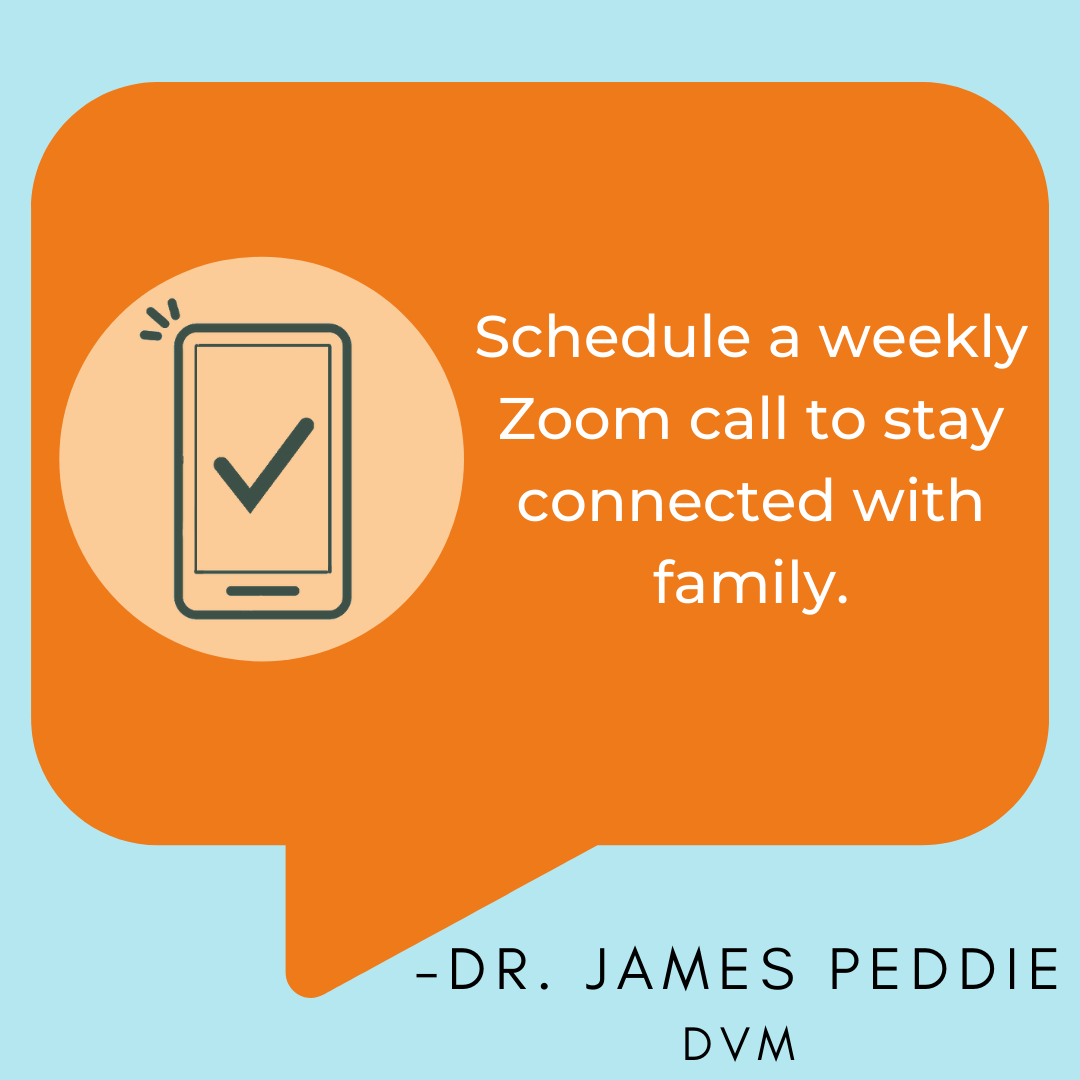Episode 4: Lions & Tigers & Neurotransmitters, Oh My! // Dr. James F. Peddie, DVM
Hosted by Hillary Wilkinson
"Neurotransmitters absolutely play a role in animal behavior."
-Dr. James Peddie, DVM
Dr. James Peddie, DVM, has been called the “Hollywood Vet.” As an exotic animal veterinarian, he has seen, diagnosed, and cared for more species than many of us have ever seen in a zoo. During his time as a practicing veterinarian, Dr. Peddie identified many behaviors and animal tendencies resulting from hormones and neurotransmitter responses.
In this episode, we explore parallel behaviors affected by the neurotransmitters cortisol and dopamine. In animals, we see behaviors that result from these two neurotransmitters being released during moments of stress and anticipation, and in humans, those same behaviors are also seen but as a result of those biochemicals being released during technology overuse. The evidence is clear that we won't be able to just reason our way out of these biochemicals in our brains. These biological blueprints are here to stay. Understanding what triggers these neurotransmitters can be helpful in deciding how much time you want to spend on screens.
Healthy Screen Habit Takeaway
Resources referenced:
Moorpark College Teaching Zoo - Moorpark, CA
Show Transcript
Hillary Wilkinson (00:02):
Today's guest is definitely not someone whom you would expect to see talking in the tech arena. In fact, the arena he's more likely to be found in is covered in sawdust or hay, and he'd be standing in the middle of it, fully prepped for surgery. His life work has consisted of getting down and dirty with some of the most interesting inhabitants of our planet. I'm talking everything from aardvarks to emus, elephants, to lions. This guy’s seen, touched, diagnosed, and on good days even delivered their babies as an exotic animal veterinarian. He had a front seat to some of the best animal actors and trainers in Hollywood. He extended this reach by getting involved in the American Humane Conservation, being part of the creation of a certification board that helps zoos and aquariums provide the very best care for animals entrusted to them, including environmental enrichment nutrition and veterinary care.
He's the recipient of multiple awards in the field of veterinary medicine acknowledged as a distinguished faculty member at America's teaching zoo and known as the guy who's pioneered many life-saving practices for endangered species. He has had a lot of titles, but I just call him dad.
You see, I got to grow up in a house where it wasn't uncommon to come home from school and find an orangutan, getting a three-year-old checkup in the laundry room. Other times, I don't remember blocking all the kitchen doors because a pair of leopard Cubs needed space to play. As my dad assessed their socializing skills. I'm so happy. He agreed to share some of his stories of watching the same neurotransmitter effects we're seeing with the overuse of technology in humans translated in animal behaviors for the sake of our listeners. I'll be formal in my introduction. I'm thrilled to be able to induce, to introduce you to Dr. James Peddie, my dad, welcome to Healthy Screen Habits.
Jim Peddie (02:14):
Wow. Holy smokes. I am overwhelmed.
Hillary Wilkinson (02:21):
Well, that's probably going to be the last time I remember to call you Dr. James Peddie. So, you know.
Jim Peddie (02:26):
Yeah. Well, yeah, well, that's great. Well, thank you. I'm, I'm, I'm, I'm truly, truly honored to be that you asked me to do this because these father-daughter tag team type things don't happen often. And this, this is a rare and wonderful opportunity, and thank you. Oh, wow.
Hillary Wilkinson (02:48):
I'm thrilled you could come on and thank you. So let's start, let's catch everyone up. Let's start at kind of like the beginning of your story. How did you get involved in working with so many different species?
Jim Peddie
(03:06):
In 1968, I was discharged from active duty in the army and I accepted a position at a veterinary hospital in Thousand Oaks, California. This practice happened to be located less than a mile from a major wildlife facility known as Jungle Land. And, um, it was probably the largest, if not one of the largest, if not the largest collection of non-domestic animals in the United States at that time. And of course the, uh, we did the veterinary work that practice did the veterinary work for these non-domestic animals. Now you have to understand, I had no training, no training at all in exotic animals. So it was really trial by fire and flying by the seat of your pants. I had a tremendous copilot that Hillary has neglected to mention, and that is my wife.
Jim Peddie (04:12):
My wife--
Hillary Wilkinson:
That's my mom.
Jim Peddie:
That's her mom. That's exactly right. That's her mom. My wife and I have to brag a little bit here. My wife was the only woman in a class of 60 students. There were 59 guys and one lady and I was the guy who married her our senior year in veterinary school. And she has been with me the whole trip. So, and we're still on that trip, I think. What is it? 56 years later, something like that. Anyway, that was it. That's how I got started in the area of non-domestics.
Hillary Wilkinson (04:56):
Awesome. Yes, I wasn't, I wasn't trying to leave Mom out of the equation. I was just focusing on--
Jim Peddie (05:06):
Don't leave mom out.
Hillary Wilkinson (05:09):
So jumping over into the Healthy Screen Habit world, we've learned that an unintended consequence with overusing technology is that it actually affects the physiology of the human brain. We hear a lot about neurotransmitters when talking about tech design neurotransmitters are the chemical messengers of our brain and the manipulation of them via reward systems using electronic notifications or video game design. And the algorithms used in social media has come to light in the past few years. So my big question is, do animals have neurotransmitters that function like the ones found in humans?
Jim Peddie (05:52):
Absolutely. Yes. There's no question that they're there. The, I would have to say-- being that this area of neuro-transmitters in humans is a relatively new-- I think, relatively new area of, of exploration of the mind and of the brain. Animals have lagged behind in a lot of that work now, recognizing they do use animals, I'm sure in some of their studies, but the in-depth studies have not been done, but they absolutely do occur.
Hillary Wilkinson (06:27):
That's so interesting. I want to hear more about those, those neurotransmitters and how you recognize them as they were coming through an animal’s behaviors right after we take this quick break.
Hillary Wilkinson (13:33):
Welcome back today. We're talking with my dad, Dr. James Peddie. He's an exotic animal veterinarian. And before the break, he was just starting to speak about the systems that we humans have in common with other species, so dad the big buzz, as far as neurotransmitters go in tech land and screen education is all about dopamine. Dopamine is kind of this celebrity neurotransmitter of the moment. It's got many functions, but the one that the tech industry has capitalized on is the role that it plays in rewards and reinforcement. Dopamine is responsible for motivation and focus, but also craving, and has been called the smoking gun of addiction, which is concerning for a lot of reasons. Psychologists are learning that the overproduction of dopamine from screen use puts kids into a hyper-stimulated state. This causes an increasing demand for instant gratification while at the same time, impairs impulse control. Have you ever seen anything like that exemplified in the animal kingdom?
Jim Peddie (15:32):
Interesting that you bring this up because yes, I have a bit of history here in addition to being a full-time veterinarian in a clinical practice setting. I taught in a one-of-a-kind program called the Exotic Animal Training and Management program located at Moorpark College, CA.
One of the keystone animals in that program was a rescue California sea. When we got her, she had just come off the beach. She was near to starvation. She was a baby. She'd been abandoned by her mom, and, we nursed her back to health. We named her Shmoo, and I will tell you that almost every student in the EATM program (the Exotic Animal Training & Management program) wanted to be assigned to Shmoo as Shmoo's trainer.
She was very, very popular. The training that she was the students were using was called the clicker technique or clicker method. And then with intermittent food rewards, the student, for an example, now the student would ask for a behavior example would be Shmoo, flipper, and you'd hold out your hand and she would place her flipper. And on your hand, that was an indication that you could do anything you, you could manipulate. And in fact, we were even doing blood draws off the surface of it. She would then-- until she was released and that would be the word, “release,” where she would take the flipper back from you--
And at that point, you had to reward her with what uh in training terminology is called a bridge. And the bridge was a simple click on this clicker that was just a little metallic device that made a sound kind of like a cricket click-click, you know, that type of thing. Your timing had to be right on in other words, a minute, she, you released her and she took her flipper back. You better be there with the click-click because if you weren't right there as the timing wasn't right there when she anticipated it, she would bump you with her nose and it would be kind of a,
Hey, wake up! You're too slow. That's essentially what she was telling you. And if you repeatedly were too slow-- and then this gets funny here, because she discriminated--
Jim Peddie (23:19):
If you were, if you were too slow and you were a lady who was doing this, she would wheel around, turn her back on you, stock off with her head held high, then she went into a full-on pout-- a drama queen. Exactly drama queen. And, and if, but if you were a guy-- because she had both men, men, and women on her as trainers-- if you were a guy, she bumped you with the nose, only this time, the teeth were out to get you a little, give you a little nip. She was definitely responding, to the, you know, that's, there was a dopamine involved response there.
Hillary Wilkinson (24:12):
Sure, sure. I knew Shmoo very well, and I was always a little intimidated by her so another neurotransmitter that's near and dear to my heart is oxytocin. Oxytocin is also known as the love hormone. It's credited with creating feelings of bonding and closeness. It's the reason why we get warm fuzzies when we hug or gaze into the eyes of someone we love. In 2017 medical news today published an article that stated research into oxytocin States that the hormone’s impact on pro-social behaviors and emotional responses contribute to relaxation, trust, and psychological stability. Brain oxytocin also appears to reduce stress responses, including anxiety. These effects have been seen in a number of species. Did you ever see any of this type of oxytocin response in an animal?
Jim Peddie (25:25):
I have, I have one of the areas of my career of which I'm very proud is the veterinary work that my wife and I have done for elephants. I have attended the birthing of four baby elephants. I've been the attending veterinarian for these. Now that may not sound like many until you realize that with in the United States. And I'm talking all the zoos and facilities that house elephants, there will be years when there are no bursts at all. And a big, big year. There may be one or two bursts. So four of them is really a big number. You know all of these births that I attended, where the mothers first attempt at, delivering a baby, and what I quickly realized, after observing not only the babies, the mothers that we had, that we were caring for, that I was part of the team caring for, but also, watching video footage of other time moms giving birth was that these elephants were experiencing a very high level of discomfort.
Jim Peddie (26:53):
And I always loved that word because in the human field, in the medical field if you're told, well, there'll be some discomfort, get ready for pay lookout. Yeah. That's, that's a nice way of saying this is really going to hurt.
Hillary Wilkinson (27:11):
And, and just out of curiosity, how big would this discomfort be and about what size of baby are we talking about?
Jim Peddie (27:19):
Well, we're coming to that. So I'll bring that up in just a minute. But anyway, the, um, the, during this birthing process, there's two principle reasons that we could identify that contributed to this wave of, of, of discomfort. And one was the length of the birth canal in the elephant is almost two to three times longer than say most birth canals are in many animals. So it's a long birth canal. And then number two, just as, as Hillary just said, how big were these babies? These babies were over 300 pounds, 300 pounds. Now, the little guy we're going to be talking about here on my, with my oxytocin analogy here, he weighed in at three-o-six, and to start with rather than being a typical anterior facial delivery he did it backwards. He came rear end first and that's never as good.
Jim Peddie (28:22):
In fact, we had to help his mom because she got along so far in this process and just said, no, I'm done. And he was not out yet. So we had to help her and we got him delivered. I will tell you that his, he was depressed, when he was delivered, he was, his color was not good and all of that, but we stayed, got him, stabilized, suction, oxygen, all of those things. And I can tell you that in the meantime, while all this is going on, his mom was throwing a Royal fit. Not because we had him away from her, but from the pain, in fact, we offered, as soon as we got him sort of stabilized, we wanted to show him to her. She, she was going to kill him. There was no, there was no, she was, she was really, really angry, and very openly aggressive towards him.
So, um, I, I mean we, were very afraid she would injure him or even worse. Now he wants to nurse he sucking on everything. He had my fingers, anything that you give him. I mean, if you, you know, we had well, the main thing was my fingers wanted to say he would, but he was also looking for the breasts that in the floor, he, you know, he, he was 180 [degrees], he was born backwards. And now he's looking for the breasts backwards. He's looking at the floor and not where the breast is, which is where it's going to be. It's up above his head, but he's sucking on everything like crazy. Back to the oxytocin thing, this business with her throwing this hissy that she was in and lunging at everything and everybody, and trying to, you know, slap at you where their trunk and all of that sort of thing probably lasted almost, I would say almost an hour or maybe a little bit less, maybe 45 minutes.
Jim Peddie (30:27):
I didn't keep time on it, but it was when we noticed that her breasts started to fill with colostrum that first milk, and actually start to drip from her nipples, that you could see a change come over her. Now we know and have known for a long time. It's oxytocin, that causes that milk let down process. So we know that hormonally, she was being flooded with oxytocin because her breasts were filling and leaking. So here we have this mom now who's all of a sudden is going through this incredible transformation from being, I'm going to - given the opportunity. I will take you down and I will do something really bad to you too. “Where's my baby? I had a baby.” Oh. And so we're showing her the baby, we incidentally have him on a little bit of a harness type arrangement so that if she shows, so she shows aggression, we can get him back out of her way.
Jim Peddie (31:35):
But because you don't know, I mean, you know, when she reverted all anyway, make a long story short. We get him in there. She accepts him. In fact, she's helping position him to her breasts all of this, but he's still trying to find the nipple on the floor. So confused. Yeah. He's, he's, he's 180 [degrees] anyway. And I, and I think about this and I, I go, boy, Oh boy, you were crazy, man. Cause I find myself underneath her. It's him and me underneath his mom's front legs. I'm on my hands and knees. I've got his chin on my shoulder. I am, he's sucking on my fingers like crazy. And I've got my other hand up. I'm milking the colostrum out of my, out of her breast onto my hand, dribbling it down on my finger. So I'm trying to get him the taste of the smell and everything like that.
Jim Peddie (32:31):
And I'm trying to shove his head up. And while all this is going on, I'm thinking, man, I can't believe how hot it is in here. I'm sweating like crazy. I had my head jammed up into her opposite breast and I was all this claustrum with just screaming down over my head and everything. So that was an experience. We did get him straightened out. He did go ahead and realize, Oh, wait a minute. It's up here. It's not wrong direction, wrong direction. And he started nursing like crazy. And I'm pleased to tell you that they, that he is the chief breeding male at the Houston zoo and the lovely collection of Asian elephants that they have.
Hillary Wilkinson
(33:13):
Oh, such a good story. Such a happy ending for him for a little boy who didn't know, didn't know up from down. That's right. Okay. Well, that's a, that's a happy story with a happy ending, but it's not over yet. We've got more fun stories after this break.
Hillary Wilkinson
(33:59):
Today I'm talking with my dad, Dr. James Peddie an exotic animal veterinarian who spent his career working with animals of all types and studying their systems of commonality. We've been talking about the role neurotransmitters and hormones play in affecting behaviors. We've heard about sea lions and elephants. And the last hormone I want to discuss is cortisol. Now cortisol is known as the stress hormone. It's best known for helping fuel your body's fight, flight, freeze instinct in a crisis. This gets hijacked in the online world because our organic brain cannot determine the difference between real world application of being chased by someone who's trying to get you and cause you harm and, or the virtual version, your brain thinks it's all the same thing. So typically after danger has passed your cortisol levels, calm down your heart, blood pressure and other body systems regulate and get back to normal. But in the world of online gaming or not even online gaming in the world of gaming, this is not true. Gamers are subjected to heightened levels of cortisol because of gaming design. And because gaming is fairly sedentary by nature, gamers are never able to discharge this cortisol through activity. So we know that long-term exposure to stress and heightened levels of cortisol can put you at risk, many health problems. And Dad, did you ever see any examples of like this in your practice?
Jim Peddie (35:38):
Yes. Yes. There's a definite definite parallel, to the sequence that you've just referred to here. In the animal world and it's with cheetahs, historically in zoos, and in private compounds, cheetahs had been very, very difficult to maintain. When they're in captivity, they experienced a very high prevalence of what has been termed unusual diseases, chief of those being gastric ulceration. They've
Also had a very dismal reproductive rate in captive cheetahs. They just don't reproduce. The breakthrough, interestingly enough, to these problems came with the ability to measure fecal cortisol levels. When that was developed, that offered a tremendous tool to determining what the cortisol levels were without having to do a blood draw. And of course, as you've just indicated, these cortisol levels move very quickly within the body in this fight or flight mechanism, so they could change very quickly. Well, now we have a tool of being able to frequently with relative ease. All we need is a fresh sample of poop and, and we can measure it. So that was done, that was studied. And what they found out was.
In the studying of captive cheetahs, they had cortisol levels, which were four times greater than those found in the wild. And she does that. We're living in the wild. So that was a huge, I mean on a, on a, when you're talking about hormonal levels of four times increase is massive. That's a huge increase, ironically they levels they also then developed a test, a very similar type tasks testing for testosterone, the male sex hormone, and found out that in captive-raised cheetahs, it was the testosterone level was four times lower than in the, their wild counterparts. So the fix to this problem, once they recognized what was really happening, we had all these very high levels of cortisone and all the effects. They long-term sustained effects from this, from being in captivity. And of course in most zoos at that time, cheetahs were housed like any other exotic cat.
And, and that is, well, we give them an acre or maybe an acre and a half, something like that. Then after all the public has to be able to see them. And if we get it too big, the public can't see them. So these poor animals when they were housed, like that were under a constant period of stress for these very high cortisol levels, the fix was, was simple. And it was, and by the way, this was pioneered in great part by the San Diego wildlife park, instead of an acre, acre and a half, two acres, they said, you know, we've got 40 acres back here that we're not using let's fence it. And we'll fence it in kind of a long, kind of a narrow, maybe 10 acres long, and just four acres wide or something like that.
And in other words, we'll give them a long-distance and guess what they found the cheetahs is going out and running flat out that distance. They were able to get that release that they needed. And, the cortisol levels dropped dramatically. And interestingly enough, they had a population explosion the following year with new babies everywhere. The situation corrected itself, and the gastric ulceration problem that I referred to earlier, that was in part brought on by these, made possible by these, by the constant stress. The actual cause of the gastric ulceration was found to be exactly the same it's that bacteria, which was, incriminated in human gastric ulceration. And, so, we got a win-win-win on this one.
Hillary Wilkinson (40:31):
That's fantastic. That's a really powerful visual. I know we've all seen cheetahs, just doing those amazing bursts of energy on the nature channels and, you know, animal planet and stuff like that. And when you talk about that, I can picture my son who is a long-distance runner. If he is not getting his feet on the ground and pounding it out, you can see it just in his demeanor. So it just, I, I don't know, I've never, I've never thought of my son as a cheetah.
Jim Peddie (41:08):
Well, I kind of liked that though. I'd like a grandson as a cheetah.
Hillary Wilkinson (41:14):
Okay. Thanks, Dad. On every episode of the Healthy Screen Habits podcast, I ask for one healthy screen habit that our guests can, uh, tell our listeners to put into practice in their own homes. Do you have one?
Jim Peddie (41:31):
Well, I, this qualifies of course this pandemic that we've been gone, and with the COVID-19 viruses thrown a monkey wrench into all of our lifestyles over and over and over again, and fairly early on in our family, we started a weekly zoom call. Uwe occurs on Wednesdays at noon, and, the whole family, anybody who's free to sit in on it does. It has kept us in touch with each other because you can't physically go and see each other. I highly recommend this as a means of corresponding with family members and friends. These zoom calls are easy to do, and, of course, there's no cost. And at a great way to, to see somebody physically on the computer it's second-best to hugging. It's never as good as hugging, but it's second best.
Hillary Wilkinson (42:58):
I agree. And it's in, in talking about stress management, there is something that lowers my stress level in being able to see people on the zoom calls and kind of just get a feel for how they're really doing. So I agree. I like that one. Well, dad, thank you so much for being here today. I think that the more people understand how much we share with the other occupants on this planet, in our animal kingdom, the more people will be motivated to protect and preserve other species. I know it's true for me, so thank you.
Jim Peddie (43:36):
You're very welcome. Thank you for having me.
About the podcast host, Hillary Wilkinson
Hillary found the need to take a big look at technology when her children began asking for their own devices. Quickly overwhelmed, she found that the hard and fast rules in other areas of life became difficult to uphold in the digital world. As a teacher and a mom of 2 teens, Hillary believes the key to healthy screen habits lies in empowering our kids through education and awareness.
Parenting is hard. Technology can make it tricky. Hillary uses this podcast to help bring these areas together to help all families create healthy screen habits.







